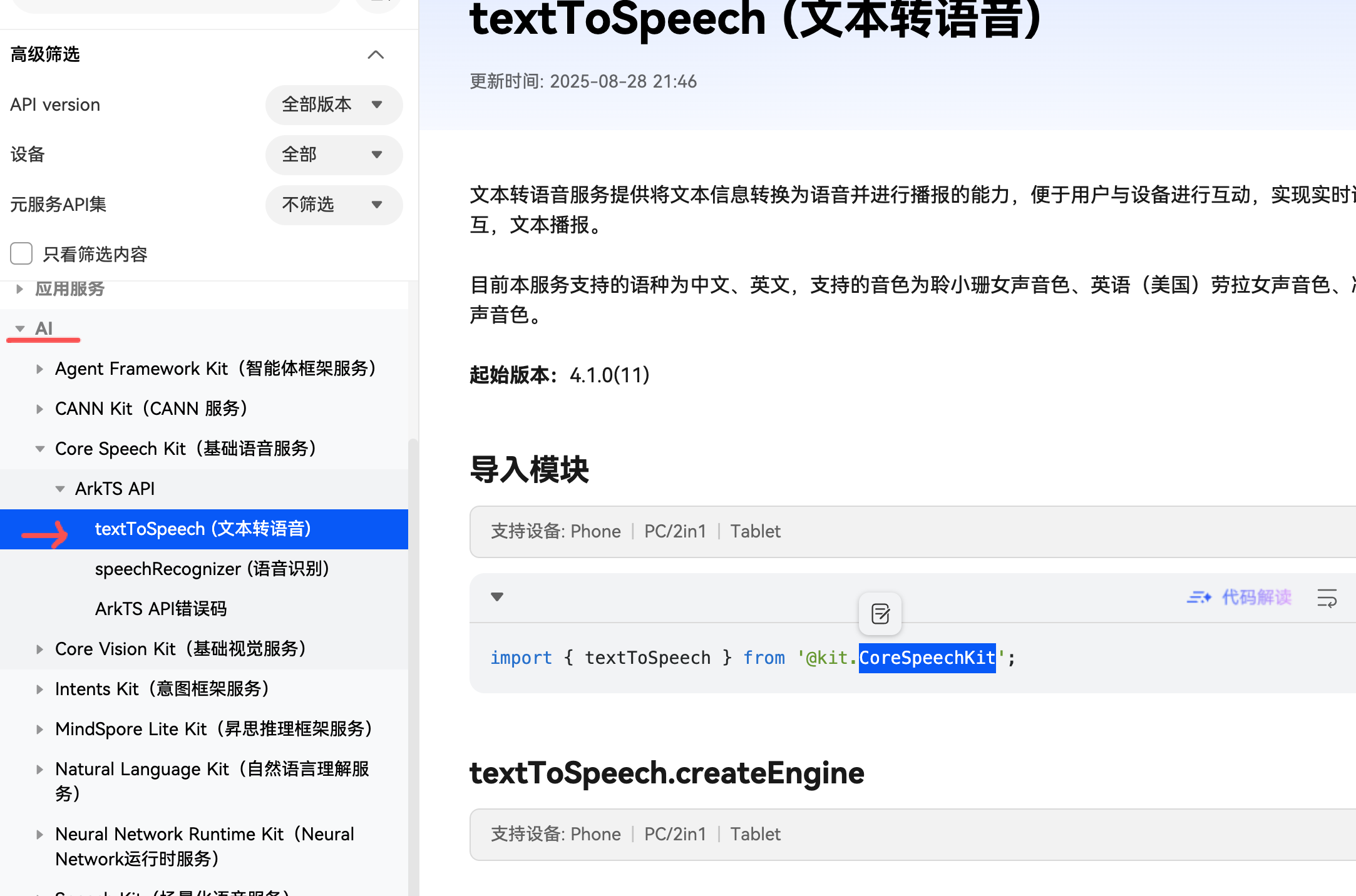#星光不负 码向未来# 鸿蒙开发实战:基于 CoreSpeechKit 实现文本转语音功能 原创
在鸿蒙应用开发中,为应用添加语音交互能力能显著提升用户体验。本文将带你快速掌握基于鸿蒙 CoreSpeechKit 实现文本转语音(TTS)的核心技术,通过三步即可让你的应用 “开口说话”。
一、认识鸿蒙TTS核心能力
鸿蒙系统内置的CoreSpeechKit提供了强大的文本转语音能力,其核心优势在于:
离线可用:支持无网络环境下运行,特别适合无障碍场景
- 多语言支持:涵盖中文(简繁体)、英文及数字播报
- 丰富音色:提供聆小珊(女声)、凌飞哲(男声)、劳拉(英语女声)三种音色
- 高容量处理:单篇文本支持最长 10000 字转换

这项能力基于系统级 AI 模块构建,与华为 “小艺” 语音助手同源,稳定性和兼容性经过严格验证,完全适配鸿蒙 Next 系统。
二、3步实现文本转语音功能
实现原理,要初始化文本转语言的引擎(TextToSpeechEngine),然后给它配置参数、配置回调;然后就可以使用它进行操作了,让它干活了。
1. 创建TTS引擎实例
首先需要初始化TextToSpeechEngine引擎,通过配置基础参数确定语言、音色等核心属性;调用createEngine接口,创建TextToSpeechEngine实例。并初始化引擎。使用callback异步回调。
createEngine(){
// 设置创建引擎参数
let extraParam: Record<string, Object> = {"style": 'interaction-broadcast', "locate": 'CN', "name": 'EngineName'};
let initParamsInfo: textToSpeech.CreateEngineParams = {
language: 'zh-CN',
person: 0,
online: 1,
extraParams: extraParam
};
// 调用createEngine方法
textToSpeech.createEngine(initParamsInfo, (err: BusinessError, textToSpeechEngine: textToSpeech.TextToSpeechEngine) => {
if (!err) {
console.info('Succeeded in creating engine');
// 接收创建引擎的实例
this.ttsEngine = textToSpeechEngine;
} else {
console.error(`Failed to create engine. Code: ${err.code}, message: ${err.message}.`);
}
});
}
2. 配置播报参数与回调
引擎创建后,需要设置播报监听回调,用于处理播报开始、完成、错误等状态;得到TextToSpeechEngine实例对象后,实例化SpeakParams对象、SpeakListener对象,并传入待合成及播报的文本originalText,调用speak接口进行播报。
initParam(){
// 设置speak的回调信息
this.speakListener = {
// 开始播报回调
onStart(requestId: string, response: textToSpeech.StartResponse) {
console.info(`onStart, requestId: ${requestId} response: ${JSON.stringify(response)}`);
},
// 合成完成及播报完成回调
onComplete(requestId: string, response: textToSpeech.CompleteResponse) {
console.info(`onComplete, requestId: ${requestId} response: ${JSON.stringify(response)}`);
},
// 停止播报回调
onStop(requestId: string, response: textToSpeech.StopResponse) {
console.info(`onStop, requestId: ${requestId} response: ${JSON.stringify(response)}`);
},
// 返回音频流
onData(requestId: string, audio: ArrayBuffer, response: textToSpeech.SynthesisResponse) {
console.info(`onData, requestId: ${requestId} sequence: ${JSON.stringify(response)} audio: ${JSON.stringify(audio)}`);
},
// 错误回调
onError(requestId: string, errorCode: number, errorMessage: string) {
console.error(`onError, requestId: ${requestId} errorCode: ${errorCode} errorMessage: ${errorMessage}`);
}
};
// 设置回调
this.ttsEngine?.setListener(this.speakListener);
}
3. 实现播报与控制功能
让它干活,调用播报方法,开发者可以通过修改speakParams主动设置播报策略。最后通过 speak 方法实现文本播报,并提供 stop 方法控制播报过程。
// 开始播放
speak(text:string){
// 设置播报相关参数
this.extraParam= {"queueMode": 0, "speed": 1, "volume": 0.1, "pitch": 1, "languageContext": 'zh-CN',
"audioType": "pcm", "soundChannel": 3, "playType": 1 };
this.speakParams = {
requestId: new Date().getTime().toString(),
extraParams: this.extraParam
};
// 调用播报方法
// 开发者可以通过修改speakParams主动设置播报策略
this.ttsEngine?.speak(text, this.speakParams);
}
// 停止播报
stop(){
// 当服务忙碌时停止播报
if(this.ttsEngine?.isBusy()){
this.ttsEngine?.stop();
}
}
三、实战应用技巧
1. 单例模式全局管理
建议将TTS功能封装为单例类,方便全局调用。我是将上述的方法,整理出了一个单例类TextToSpeechManager,方便在APP中全局使用。
private textToSpeechManger = TextToSpeechManager.getInstance();
2. 页面生命周期集成
在将要进入页面时,在方法aboutToAppear()中进行初始化。确保使用时已就绪。
aboutToAppear() {
/// 初始化文本转语言引擎
this.textToSpeechManger.createEngine();
this.textToSpeechManger.initParam();
}
3.传入文本,生成语音
this.textToSpeechManger.speak('Hello kit');
4.使用技巧
- 设置停顿,[p500],表示停顿500ms
this.textToSpeechManger.speak('Hello[p500] kit');
四、后记
1.展示(Show your Time)
我不知道怎么上传视频,还是算了吧。就上传一张图片吧。

2.参考文档
3.代码奉上(仅供参考)
import { textToSpeech } from '@kit.CoreSpeechKit';
import { BusinessError } from '@kit.BasicServicesKit';
/**
* 文本转语音
* 使用:Core Speech Kit
* 支持将一篇不超过10000字数的中英文文本(简体中文、繁体中文、数字、英文)合成为语音,并以选定音色进行播报。
* 场景支持
* 手机/平板等设备在无网状态下,系统应用无障碍(屏幕朗读)接入文本转语音能力,为视障人士或不方便阅读场景提供播报能力。
*/
export class TextToSpeechManager{
private static instance: TextToSpeechManager;
private constructor() {}
public static getInstance(): TextToSpeechManager {
if (!TextToSpeechManager.instance) {
TextToSpeechManager.instance = new TextToSpeechManager();
}
return TextToSpeechManager.instance;
}
// 创建TextToSpeechEngine实例
private ttsEngine: textToSpeech.TextToSpeechEngine|null = null;
// 设置播报相关参数
private extraParam: Record<string, Object>|null = null;
// 实例化SpeakParams对象
private speakParams: textToSpeech.SpeakParams|null = null;
// SpeakListener对象,设置speak的回调信息
private speakListener: textToSpeech.SpeakListener|null = null;
/**
* 调用createEngine接口,创建TextToSpeechEngine实例。
* createEngine接口提供了两种调用形式,当前以其中一种作为示例,其他方式可参考API参考。
* 其他创建方式:https://developer.huawei.com/consumer/cn/doc/harmonyos-references/hms-ai-texttospeech
*/
createEngine(){
// 设置创建引擎参数
let extraParam: Record<string, Object> = {"style": 'interaction-broadcast', "locate": 'CN', "name": 'EngineName'};
let initParamsInfo: textToSpeech.CreateEngineParams = {
language: 'zh-CN',
person: 0,
online: 1,
extraParams: extraParam
};
// 调用createEngine方法
textToSpeech.createEngine(initParamsInfo, (err: BusinessError, textToSpeechEngine: textToSpeech.TextToSpeechEngine) => {
if (!err) {
console.info('Succeeded in creating engine');
// 接收创建引擎的实例
this.ttsEngine = textToSpeechEngine;
} else {
console.error(`Failed to create engine. Code: ${err.code}, message: ${err.message}.`);
}
});
}
/**
* 得到TextToSpeechEngine实例对象后,实例化SpeakParams对象、SpeakListener对象,并传入待合成及播报的文本originalText,调用speak接口进行播报。
*/
initParam(){
// 设置speak的回调信息
this.speakListener = {
// 开始播报回调
onStart(requestId: string, response: textToSpeech.StartResponse) {
console.info(`onStart, requestId: ${requestId} response: ${JSON.stringify(response)}`);
},
// 合成完成及播报完成回调
onComplete(requestId: string, response: textToSpeech.CompleteResponse) {
console.info(`onComplete, requestId: ${requestId} response: ${JSON.stringify(response)}`);
},
// 停止播报回调
onStop(requestId: string, response: textToSpeech.StopResponse) {
console.info(`onStop, requestId: ${requestId} response: ${JSON.stringify(response)}`);
},
// 返回音频流
onData(requestId: string, audio: ArrayBuffer, response: textToSpeech.SynthesisResponse) {
console.info(`onData, requestId: ${requestId} sequence: ${JSON.stringify(response)} audio: ${JSON.stringify(audio)}`);
},
// 错误回调
onError(requestId: string, errorCode: number, errorMessage: string) {
console.error(`onError, requestId: ${requestId} errorCode: ${errorCode} errorMessage: ${errorMessage}`);
}
};
// 设置回调
this.ttsEngine?.setListener(this.speakListener);
}
/**
* 调用播报方法
* 开发者可以通过修改speakParams主动设置播报策略
*/
speak(text:string){
// 设置播报相关参数
this.extraParam= {"queueMode": 0, "speed": 1, "volume": 0.1, "pitch": 1, "languageContext": 'zh-CN',
"audioType": "pcm", "soundChannel": 3, "playType": 1 };
this.speakParams = {
requestId: new Date().getTime().toString(), //'123456', // requestId在同一实例内仅能用一次,请勿重复设置
extraParams: this.extraParam
};
// 调用播报方法
// 开发者可以通过修改speakParams主动设置播报策略
this.ttsEngine?.speak(text, this.speakParams);
}
/**
* 停止调用播报方法
* 当需要停止合成及播报时,可调用stop接口。
*/
stop(){
// 当需要查询文本转语音服务是否处于忙碌状态时
// 才停止播报
if(this.ttsEngine?.isBusy()){
this.ttsEngine?.stop();
}
}
}
/// 使用实例:
// 1.初始化语言引擎和配置
// private textToSpeechManger = TextToSpeechManager.getInstance();
//
// aboutToAppear() {
// /// 初始化文本转语言引擎
// this.textToSpeechManger.createEngine();
// this.textToSpeechManger.initParam();
// }
// 2.传入文本,生成语音
// this.textToSpeechManger.speak('Hello kit');
// 3.设置停顿 [p500],500ms
// this.textToSpeechManger.speak('Hello[p500] kit');
五、总结
通过本文介绍的方法,你可以快速为鸿蒙应用添加专业级文本转语音功能,无论是无障碍服务、语音助手还是内容播报场景,都能轻松应对。赶紧动手试试,让你的应用 “开口说话” 吧!



















